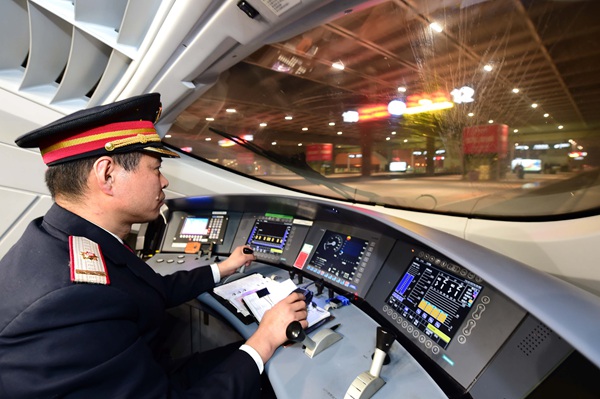
Xue Jun drives a bullet train heading to Beijing South Railway Station in February. (GUO XULEI/XINHUA NEWS AGENCY)
From steam locomotives to bullet trains, Shandong man ran them all
For train driver Xue Jun, locomotives are not machines, but friends with whom he must communicate.
The 47-year-old, who drives a bullet train for the railway bureau of Jinan, the capital city of East China's Shandong province, said the language for communicating with locomotives is a set of standard operations.
"Although I work alone in a bullet train locomotive, I frequently make gestures and read out the orders so it sounds like I am talking to my friends," Xue said.
Zhou Lei, an instructor of Xue's, said that the gestures and soliloquies can help drivers concentrate, which is critical to their work.
In 27 years, using standard operations, Xue has run trains for 2.47 million kilometers-roughly 61 times the circumference of the Earth at the equator-without an accident.
Xue-who has received driving licenses for steam, diesel and electric locomotives and now bullet trains-is very proud of the rapid development of the country's railroad industry.
"When I entered the railway system in the 1980s, I never expected that the trains would have been upgraded at such a fast pace," he said.
Influenced by his grandfather, who worked as a train maintenance man, and his uncle, who was a train driver, Xue has liked trains since childhood.
"It was the steam whistle that evoked my dream of being a train driver," he said.
In 1985, Xue started work as a fireman, responsible for adding coal to the firebox of a steam locomotive.
"People admired me for working on a train, but they really didn't know how hard it was to work in a steam locomotive," he said.
A steam locomotive needs three people-two drivers and a fireman. At that time, Xue worked 12-hour shifts, during which he added about 6 tons of coal to the firebox.
Xue described his workplace on a steam train as dirty, messy and difficult. "After work, I was all covered in black," he said.
Two years later, he obtained a driving license for steam trains.
"The first month after I got the driving license, my salary was raised to 67 yuan ($11), 20 yuan higher than my father earned at that time," Xue said.
Xue drove steam trains for four years and got his license for diesel locomotives in 1992.
"My workplace was moved into a 'big and clean house'," he said.
"Only two people are needed on a diesel locomotive-an engineer and a conductor (usually called driver and deputy driver)," said Xue.
In addition to significant operating advantages over steam locomotives, like easy switching of tracks, the operating environment is much more attractive.
"It is fully weatherproofed and without the dirt and heat that was inevitable when operating a steam locomotive," said Xue.
"We have fans and electric stoves to boil water. On a steam locomotive, we needed to use a shovel to hold the kettle in the firebox," Xue recalled.
After driving diesel locomotives for 14 years, Xue began to drive electric locomotives after getting a license in 2006.
"Amenities-including a refrigerator, microwave oven, electric heater and air conditioner-are in the driving room of an electric locomotive," he said. "And we don't need to clean the locomotive by ourselves anymore."
For a diesel locomotive, the two drivers had to spend about two hours cleaning the cabin, Xue said.
"Now the cleaning equipment can finish the work within 15 minutes," he said.
Xue said electric locomotives are quiet because there is no engine noise and less mechanical noise.
After bullet trains took to the tracks to transport passengers, Xue got that license in 2008.
He compared the examinations for the bullet train license to China's college entrance examination, or gaokao.
"It's even more difficult than the gaokao," he said. "We have more than 500 pages of theoretical knowledge to learn."
Xue failed the examination the first time he took it.
"It's really difficult for a person like me who is over 40 years old to memorize so many theories, such as the train's structure," he said.
Psychological and etiquette training have been added to a drivers' training courses, said Xue.
Last May, his driving license for the bullet train was upgraded to one that certifies he can drive bullet trains running as fast as 350 km/h.
Xue gave special thanks to his wife for his success. "If my parents or child get sick, she won't tell me during my work time to ensure I can focus on work," said Xue.
The experienced driver feels a little sorry for his son, who works in a field unrelated to the railway system.
"I do hope he can work as a train driver, witnessing how our trains will develop in the future in the same way I did over the past three decades," he said.
















































